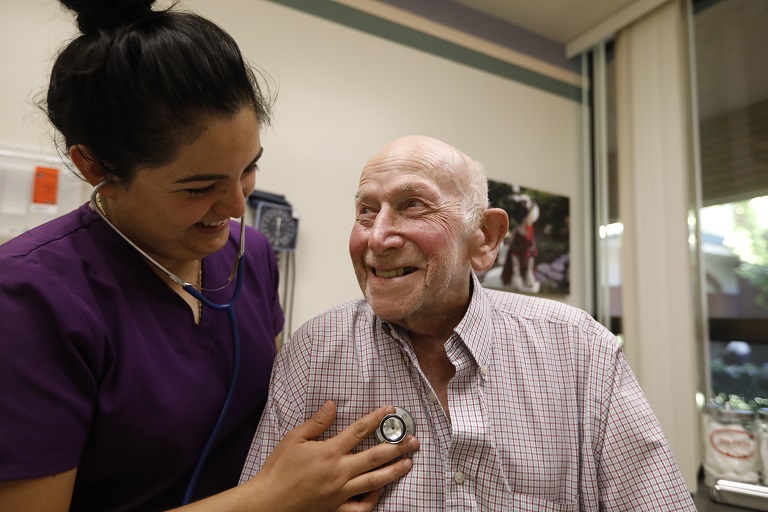CAST Recommends OASH Make Telehealth Flexibilities Permanent
When the Office of the Assistant Secretary for Health (OASH) asked how to best leverage new technologies to address chronic disease management in underserved populations of older adults, LeadingAge CAST recommended these approaches:
- Make key pandemic-related telehealth provisions a permanent part of the Medicare program,
- Provide adequate reimbursement to aging services providers, and
- Invest in broadband and health IT.
Majd Alwan, Ph.D., CAST executive director and senior vice president of technology and business strategy for LeadingAge, responded to the recent Request for Information on behalf of LeadingAge CAST. OASH is part of the United States Department of Health and Human Services.
Alwan proposed several new federal policies that could advance technology-driven solutions for aging populations.
- Keep key pandemic flexibilities. Permanently remove the geographic restrictions on telehealth, continue allowing the home to be an originating site of care, and permanently expand the providers who can furnish telehealth services for physical and mental health.
- Provide adequate reimbursement from all payer sources to sustain the investments aging services providers already made in delivering care via telehealth. Reimbursement should cater for technology upgrades and staffing. It should cover paying trained staff, like therapists and nurses, to deliver interventions via telehealth or to assist a remote physician during a telemedicine visit.
- Reimburse home health telehealth visits. Support efforts that allow Medicare reimbursement with appropriate guardrails and visit equivalency between in-person and virtual visits.
- Allow home health nurses, therapists, and other licensed professionals to use and bill beyond the pandemic for telehealth services such as remote patient and medication adherence monitoring. LeadingAge CAST will advocate to create claims codes or modifiers that allow these technologies to be used and reimbursed.
- Invest in broadband, especially in rural and underserved areas, to make sure telehealth is accessible nationwide. This investment is especially needed in affordable senior housing communities and for providers who treat patients in their own homes, such as home healthcare, hospice, and Programs of All-Inclusive Care for the Elderly (PACE) providers. Many of these entities lack connectivity.
- Continue to invest in broader health IT. Information management and secure health information exchange are critically important, and aging services providers need to be included.
- Allow flexible modalities: Continue allowing flexible modalities for video-audio connections such as FaceTime or other smartphone technology, including audio-only, to deliver telehealth services.
- Permanently allow hospice face-to-face recertification.
- Support meaningful use and health information exchange: Previous funding efforts supported healthcare providers’ transition to electronic health record (EHR) systems that contain patients’ medical and treatment histories, and aging services providers were not included. LeadingAge CAST will continue to advocate for funding and payment incentives, including incentives tied to quality, to assist aging services providers in accessing EHR technology that interoperates with that of their physician and hospital partners and peers. These resources will encourage bi-directional information exchange.
Proposed Partnerships
Alwan also recommended that demonstrations include telehealth and incentivize long-term and post-acute care providers to participate.
Several groups could partner on demonstrations of new payment models that use telehealth and other technologies to benefit aging Americans in different living and geographic settings—the Centers for Medicare & Medicaid Services / Center for Medicare & Medicaid Innovation, aging services providers, and third-party academic evaluators.
A letter that LeadingAge submitted in response to the Congressional Telehealth Caucus Request for Information on Comprehensive Telehealth Legislation Recommendations offers examples of telehealth demonstration programs. LeadingAge, CAST, its LTSS Center for Applied Research at the University of Boston, and many of its aging services provider members could be part of this collaborative effort.
Read the full CAST response to the Request for Information.

Most Recommended
October 15, 2025
 Shutdown Week Three: Impact of Ongoing Closure on Affordable Housing
Shutdown Week Three: Impact of Ongoing Closure on Affordable Housing
December 10, 2025
Fiscal Year (FY) Funding 2026
October 07, 2025
Immigrant Workforce Matching Program Brings Workforce Relief
Recently Added
December 19, 2025
House Moves Forward on Affordable Housing Reforms
December 19, 2025
White House Cannabis EO Paves Way for Research, Access
December 19, 2025
LeadingAge Urges DHS to Maintain "Public Charge" Guardrails
December 18, 2025



